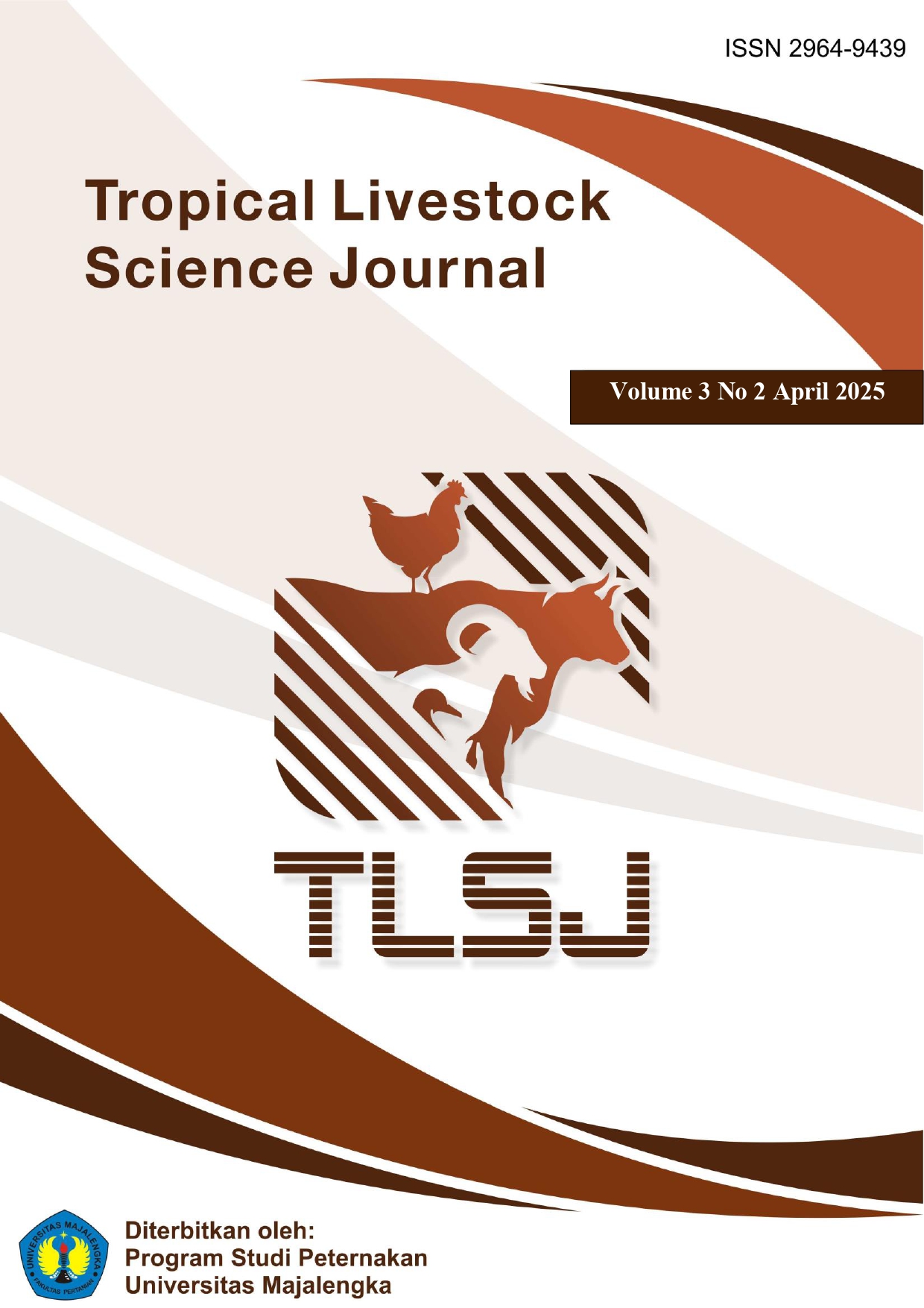Uji Kualitas Kompos Feses Ayam Petelur Berdasarkan Variasi Dosis Probiotik Dan Lama Pengomposan
DOI:
https://doi.org/10.31949/tlsj.v3i2.13358Abstrak
This research was carried out from July 30 to September 2 2024. This research aims to test the quality of laying chicken feses compost based on variations in probiotic dosage and composting time. The variations in probiotic doses used were 0%, 5%, 10%, and 15%, with composting times of 14, 21, and 28 days. This research used a Completely Randomized Design (CRD) method with a 4 x 3 factorial pattern, namely four levels of probiotic dosage and three levels of composting time, with each treatment combination repeated three times. The data obtained were analyzed using the General Linear Model and continued with the Tukey test to determine differences between treatments at the 5% level. The parameters measured include nitrogen (N), phosphorus (P), potassium (K), and composting temperature. The results showed that the addition of probiotics and composting time had a significant effect on compost quality (P<0.05). The interaction between probiotic dose and composting time did not have a significant impact. A 10% probiotic dose produced the highest nitrogen (1.33%) and phosphorus (0.37%) content on day 28, which meets compost quality standards based on the Indonesian National Standard (SNI). The highest potassium content (2.17%) was found at a 5% probiotic dose on day 28. Composting temperature reached its peak on day 21, with the highest temperature in the 5% probiotic treatment (36°C). The conclusion from this research is that a 10% probiotic dose with a composting time of 28 days is an ideal combination to produce high quality laying hen feses compost.
Kata Kunci:
Compost quality, Composting duration, Layer chicken manure, ProbioticsUnduhan
Referensi
Amoo, A. E., & Babalola, O. O. (2017). Ammonia-oxidizing microorganisms: Key players in the promotion of plant growth. Journal of Soil Science and Plant Nutrition, 17(4), 935–947. https://doi.org/10.4067/S0718-95162017000400008
Badan Standardisasi Nasional. (2004). Spesifikasi kompos dari sampah organik domestik. Badan Standardisasi Nasional, 12.
Busato, J. G., Zandonadi, D. B., Mól, A. R., Souza, R. S., Aguiar, K. P., Júnior, F. B. R., & Olivares, F. L. (2017). Compost biofortification with diazotrophic and P-solubilizing bacteria improves maturation process and P availability. Journal of the Science of Food and Agriculture, 97(3), 949–955. https://doi.org/10.1002/jsfa.7819
Dewilda, Y., & Apris, I. (2016). Studi Optimasi Kematangan Kompos Dari Sampah Organik dengan Penambahan Bioaktivator Limbah Rumen dan Air Lindi. Seminar Nasional Sains Dan Teknologi Lingkungan, 6, 95–100.
Huzairi, M., Zainudin, M., Zulkarnain, A., Azmi, A. S., Muniandy, S., Sakai, K., Shirai, Y., & Hassan, M. A. (2022). Enhancement of Agro-Industrial Waste Composting Process via the Microbial Inoculation : A Brief Review. Agronomy, 12, 198.
Kuypers, M. M. M., Marchant, H. K., & Kartal, B. (2018). The microbial nitrogen-cycling network. Nature Reviews Microbiology, 16(5), 263–276. https://doi.org/10.1038/nrmicro.2018.9
Lim, L. Y., Chua, L. S., & Lee, C. T. (2015). Effects of microbial additive on the physiochemical and biological properties of oil palm empty fruit bunches compost. Journal of Engineering Science and Technology, 10(Spec.issue5), 10–18.
Nemet, F., Perić, K., & Lončarić, Z. (2021). Microbiological activities in the composting process: A review. Columella: Journal of Agricultural and Environmental Sciences, 8(2), 41–53. https://doi.org/10.18380/szie.colum.2021.8.2.41
Ortega-Torres, A. E., Rico-García, E., Guzmán-Cruz, R., Torres-Pacheco, I., Tovar-Pérez, E. G., & Guevara-González, R. G. (2021). Addition of phosphatases and phytases to mature compost to increase available phosphorus: A short study. Agronomy, 11(12). https://doi.org/10.3390/agronomy11122555
Prasanthi, N., Bhargavi, S., Machiraju, P. V. S., & Professor, A. (2016). Chicken Feather Waste-A Threat to the Environment. International Journal of Innovative Research in Science, Engineering and Technology, 5(9), 16759–16764. https://doi.org/10.15680/IJIRSET.2016.0509188
Roy, D., Gunri, S. K., Neogi, S., Ali, O., Sharma, J., Bhadu, A., & Singh, B. (2022). Effect of Microbes in Enhancing the Composting Process: A Review. International Journal of Plant & Soil Science, 34(23), 630–641. https://doi.org/10.9734/ijpss/2022/v34i232469
Sánchez, Ó. J., Ospina, D. A., & Montoya, S. (2017). Compost supplementation with nutrients and microorganisms in composting process. Waste Management, 69(26), 136–153. https://doi.org/10.1016/j.wasman.2017.08.012
Simandi, P., Takayanagi, M., & Inubushi, K. (2005). Changes in the pH of two different composts are dependent on the production of organic acids. Soil Science and Plant Nutrition, 51(5), 771–774. https://doi.org/10.1111/j.1747-0765.2005.tb00110.x
Simanungkalit, R. D. M., Suriadikarta, D. A., Saraswati, R., Setyorini, D., & Hartatik, W. (2006). Pupuk Organik Dan Pupuk Hayati Organic Fertilizer and Biofertilizer. In Balai Besar Litbang Sumberdaya Lahan Pertanian.
Skóra, J., Matusiak, K., Wojewódzki, P., Nowak, A., Sulyok, M., Ligocka, A., Okrasa, M., Hermann, J., & Gutarowska, B. (2016). Evaluation of microbiological and chemical contaminants in poultry farms. International Journal of Environmental Research and Public Health, 13(2), 1–16. https://doi.org/10.3390/ijerph13020192
Sri Muliani, D. O. dan S. (2022). Uji Karakteristik Fisik (pH, Suhu, Tekstur,Warna, Bau Dan Berat) Kompos Tumbuhan Pakis Resam (Gleichenia Linearis ) Yang Di Perkayakotoran Sapi. Jurnal Green Swarnadwipa, 18(2), 120–122.
Suhesy’, & Adriani. (2020). Pengaruh Probiotik Dan Trichorderma Terhadap Hara Pupuk Kandang Yang Berasal Dari Feses Sapi Dan Kambing. Jurnal Ilmiah Ilmu-Ilmu Peternakan Universitas Jambi, XVII (2), 45–53.
Yatoo, A. M., Bhat, S. A., Ali, M. N., Baba, Z. A., & Zaheen, Z. (2022). Production of Nutrient-Enriched Vermicompost from Aquatic Macrophytes Supplemented with Kitchen Waste: Assessment of Nutrient Changes, Phytotoxicity, and Earthworm Biodynamics. Agronomy, 12(6). https://doi.org/10.3390/agronomy12061303
Diterbitkan
Cara Mengutip
Terbitan
Bagian
Lisensi
Hak Cipta (c) 2025 Ucup Supriatna, Rachmat Somanjaya, Oki Imanudin

Artikel ini berlisensiCreative Commons Attribution-ShareAlike 4.0 International License.








